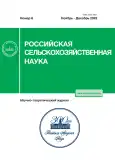Sensitivity of the causative agent of net blotch of barley (Pyrenophora teres Drechsler) to fungicides
- Authors: Volkova G.V.1, Yakhnik Y.V.1
-
Affiliations:
- Federal Research Center of Biological Plant Protection
- Issue: No 6 (2023)
- Pages: 33-37
- Section: Articles
- URL: https://journals.rcsi.science/2500-2627/article/view/233871
- DOI: https://doi.org/10.31857/S2500262723060078
- EDN: https://elibrary.ru/NJHIXM
- ID: 233871
Cite item
Full Text
Abstract
About the authors
G. V. Volkova
Federal Research Center of Biological Plant Protection
Email: galvol.bpp@yandex.ru
350039, Krasnodar, p/o 39
Ya. V. Yakhnik
Federal Research Center of Biological Plant Protection350039, Krasnodar, p/o 39
References
- Worku A. Barley Net Blotch Disease Management: A Review // Agriculture Journal IJOEAR. 2021. No. 7. P. 69-81.
- Физиологические эффекты действия на растения фунгицидов триазольной природы / Т. П. Побежимова, А. В. Корсукова, Н. В. Дорофеев и др. // Известия вузов. Прикладная химия и биотехнология. 2019. Т. 9. №. 3 (30). С. 461-476. doi: 10.21285/2227-2925-2019-9-3-461-476.
- Deising H. B., Reimann S., Pascholati S. F. Mechanisms and significance of fungicide resistance // Brazilian Journal of Microbiology. 2008. No. 39. Р. 286-295. doi: 10.1590/S1517-838220080002000017.
- Lucas J. A., Hawkins N. J., Fraaije B. A. The evolution of fungicide resistance // Advances in Applied Microbiology. 2015. No. 90. Р. 29-92. doi: 10.1016/bs.aambs.2014.09.001.
- Андреева Е. И., Зинченко В. А. Системные фунгициды - ингибиторы биосинтеза эргостерина // АгроXX I. 2002. № 4. С. 14-15.
- Kinetics and new mechanism of azoxystrobin biodegradation by an Ochrobactrum anthropi strain SH14 / Y. Feng, W. Zhang, S. Pang, et al. // Microorganisms. 2020. Vol. 8. No. 5. URL: https://www.ncbi.nlm.nih.gov/pmc/articles/PMC7284741/ (дата обращения: 10.08.23).
- A Review on the Biotechnological Applications of the Operational Group Bacillus amyloliquefaciens / M. S. Ngalimat, R. S. R. Yahaya, M. M. Baharudin, et al. // Microorganisms. 2021. Vol. 9. URL: https://www.mdpi.com/2076-2607/9/3/614 (дата обращения: 10.08.23). doi: 10.3390/microorganisms9030614.
- Development of an international standard set of barley differential genotypes for Pyrenophora teres f. teres / O. S. Afanasenko, M. Jalli, H. O. Pinnschmidt, et al. // Plant Pathology. 2009. Vol. 58. No. 4. Р. 665-676.
- Методика определения биологической эффективности фунгицидов в отношении грибов рода Fusarium и их резистентности к химическим препаратам / В. В. Чекмарев, Ю. В. Зеленева, Г. Н. Бучнева и др. // Тамбов: Принт-Сервис, 2015. 61 с.
- Shannon C. E. The Mathematical Theory of Communication. Urbana: University Illinois Press. 1949. 117 p.
- Infectious plant diseases: Etiology, current status, problems and prospects in plant protection / P. A. Nazarov, B. D. Naleev, M. I. Ivanova, et al. // Acta naturae. 2020. Vol. 12. No. 3. URL: https://www.ncbi.nlm.nih.gov/pmc/articles/PMC7604890/ (дата обращения: 10.08.23). doi: 10.32607/actanaturae.11026.
- Щербакова Л. А. Развитие резистентности к фунгицидам у фитопатогенных грибов и их хемосенсибилизация как способ повышения защитной эффективности триазолов и стробилуринов // Сельскохозяйственная биология. 2019. № 54. С. 875-891. doi: 10.21285/2227-2925-2019-9-3-461-476.
- Pyrenophora teres: taxonomy, morphology, interaction with barley, and mode of control / A. Backes, G. Guerriero, A. Barka, et al. // Frontiers in plant science. 2021. Vol. 12. URL: https://www.frontiersin.org/articles/10.3389/fpls.2021.614951/full (дата обращения: 10.08.23). doi: 10.3389/fpls.2021.614951.
Supplementary files









